Lively, bustling, cheerful and never sleeping – or hot, sleepy all day and coming to life only at night? Seville can be so different, and to see the city and feel its rhythm and tastes without wasting a minute, you need to know what to prepare for
When to go to Seville: holidays, festivals and weather
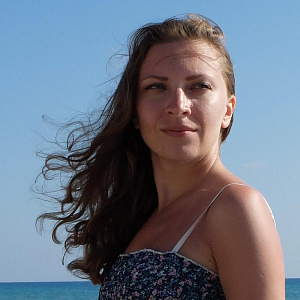
Seville is one of the hottest cities in Spain. In July and August the temperature is around 40℃. Because of the heat, from which you can’t hide and because of which it’s impossible to spend daylight hours in the city, Seville was nicknamed the “Spanish frying pan”. The townspeople have learned to live with such a climate, but for a tourist this is a problem: it is impossible to be outside at such hours. During the day, air-conditioned bars and shops save you from the heat, and only closer to sunset the city fills with people.
The most touristic time in Seville is April-May and September-October:
- From June to September the temperature is between 30-36℃ and it rains only 1-2 days a month. The air is dry and hot.
- In May and October – about 26 ℃ and 3-5 rainy days. You can sunbathe and walk. The jacket is no longer needed.
- March, April and November are the easiest months to walk around the city: the average temperature is around 20℃ and there are 3-6 rainy days per month. During the day, they wear T-shirts here, and in the evening they take out light jackets. The British at 20℃ wear shorts and sandals, but by the evening, when the temperature drops to 8℃, even they are noticeably cold.
- In December, January and February, it rains about once every 5 days, and the temperature is about 16-18 ℃.
The weather can vary slightly from year to year. For example, in February 2020, the temperature rose to 26 ℃, and there were summer months in the history of Seville with temperatures around 20 ℃. The maximum temperature that meteorologists recorded in the city in the entire history of observations is 45 ℃.
In the off-season, the weather can change rapidly: sunny and clear in the morning, wind picks up in the evening, and rain can fall at night. For a week in Seville in late February – early March, I managed to get burned in the sun and twice got caught in the rain.
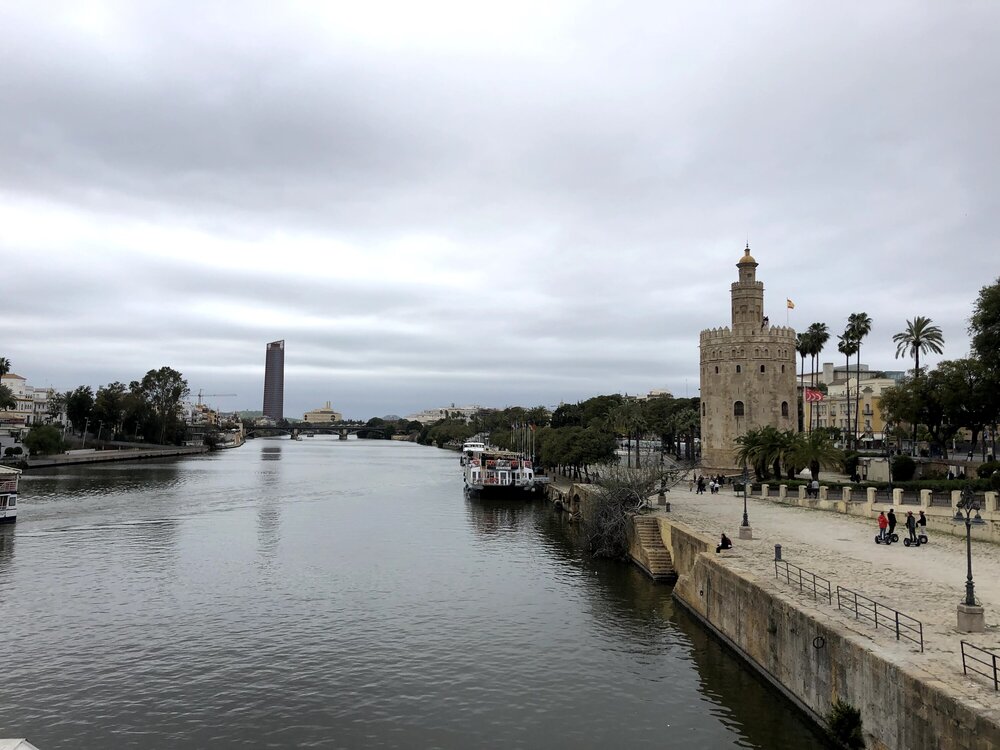 In March, the weather is unpredictable, it can rain, but it is warm
In March, the weather is unpredictable, it can rain, but it is warm
Schedule of the day and week
Under such a climate, the whole life of the city adapts.
- In the morning, all organizations, shops and trade shops are open. It is easiest to have breakfast or a snack at this time in bakeries and pastry shops. Small bars are also open, but even in them, local residents mostly drink coffee in the morning.
- Tapas bars and restaurants open at 12:00. From this moment until 15:00, most organizations and small private shops are closed: their employees flow into the opened establishments. Drink a glass of sherry and have a bite of one or two tapas – that's the whole dinner.
- At 15:00-16:00 establishments for locals are closed, shops reopen and work until 19:00-20:00. You can have a snack from 16:00 to 20:00 only in tourist establishments and in several good tapas bars, which for some reason work even at this time.
- Tapas bars reopen between 20:00 and 20:30.Until 22:00, they literally boil, and then they slow down gradually, and by midnight the majority closes.
Most stores are closed during the day on the siesta, which lasts an average of 14.00 to 17.00. Only large shopping centers, such as El Corte Inglés, can afford to work all day.
On Sunday, most shops and good authentic institutions are closed. Even the El Corte Ingles trading network does not work. Many bars “for local” open only on Tuesday.
However, in Seville, tourism influenced the rhythm of the city’s life: many good establishments that became popular among tourists thanks to bloggers and reviews in Tripadvisor were adjusted to a new reality and are ready to feed the hungry traveler even on Sunday. Buying a bottle of water in the center is also not a problem: almost all Carefour supermarkets and small shops – Alimentacion work.
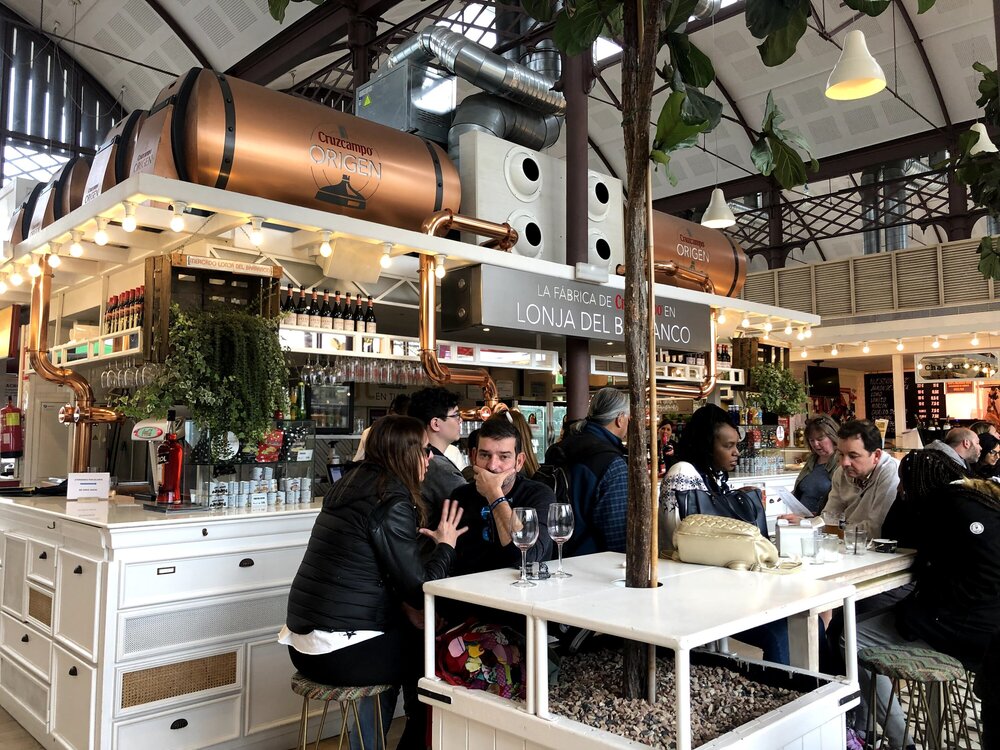 You can eat at any time of the day on a gastr market near the Triana district
You can eat at any time of the day on a gastr market near the Triana district
Holidays in Seville
It seems that Andalusia is constantly celebrating something. During the year, there are several public holidays in the region, when everything is closed, and two periods when the Spaniards seek to leave on vacation – Seman Santa and the second half of August. In these weeks, Seville is empty, many establishments and private stores are closed.
Several local festivals become bright tourist events and gather tens of thousands of guests. This is a carnival in Cadiz, Seman Santa (Easter Week), the Seville Fair and Christie’s building.
Carnival in Cadiz
Crazy and satirical, Cadis carnival is the most massive in Spain after the carnival in the Grand Canarius. Even Franco could not ban him. It has been held in Cadiz since the 16th century, when the port city had strong trade relations with Venice, and therefore is largely similar to Venetian.
The carnival is dedicated to the beginning of Great Lent, so it takes place in late February – early March. The dates of the carnival become known in a few months, and they publish the exact program very late: in one or two weeks. Despite the lack of the program until the last moment, the hotels numbers are rapidly ending as soon as the dates of the carnival are announced: regular visitors know the annual daily routine and know when to go.
The carnival consists of performances (mainly satirical) singers and street festivities. Pafflets on topical topics make fun of situations and characters – local celebrities, church, government – all that was recently in the news, so it is very funny for local ones, but it is not always clear to tourists. The main place of the song contest is the Gran Teatro de Falla Theater, and after performances in the theater of the groups of singers, they perform their purchases in city squares and streets. These groups and their satirical purchases are the main “feature” of Cadiz Carnival. Street flamenco, samba, clowning, puppet performances, comedian performances – the whole city for 10 days becomes one large stage platform.
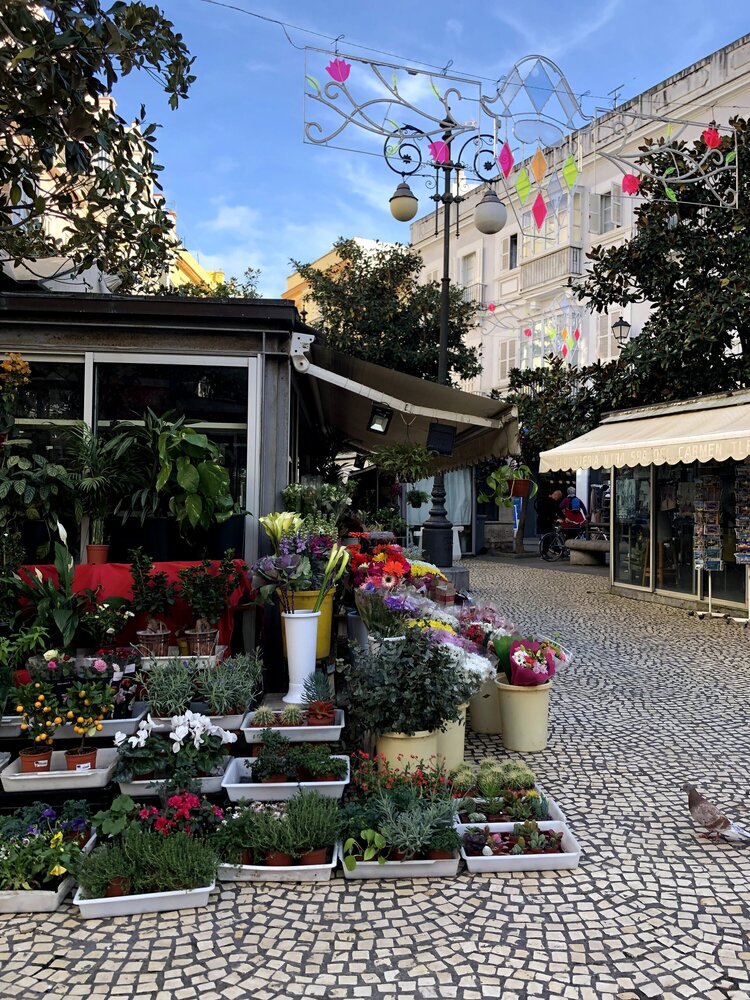 Kadis after a carnival: everyone is sleeping except pigeons
Kadis after a carnival: everyone is sleeping except pigeons
From street events, the most significant takes place in two weekends: tourists flock to Cadiz on Saturdays and leave on Sunday. On the first Saturday – the official opening of the carnival, and the next day, on the first Sunday, at about 17:00 passes Gran Cabalgata (Large parade). The second weekend of Carnival is a humorous Cabalgata del Humor (Comedy parade) and the solemn ceremonial “burning of Sardina” – so, with humor, the Spaniards say goodbye to meat for the period of Great Lent. Each weekend ends with fireworks.
The carnival begins in trains and buses on the way to Cadiz: dressed up people in carnival costumes arrive in Cadiz already well heated. Many of them do not go to bed, and in the morning with the first flights they travel to the neighboring towns so that in the evening of Sunday to return to Cadiz again. In order not to look like a white sheep, even tourists should come to the carnival to be dressed up.
During the carnival, three special gastromerias are held: Pestiñada (Fried pastries festival), OSTIONADA (oyster party) and Erizada (Party of the sea hedgehog). Their dates must be clarified in the program.
During the pandemic, the carnival is transferred to other months. For example, in 2022 he was postponed from February to June.
The main locations of the carnival:
- Gran Teatro Falla – the official competition of singers.
- Barrio de la viña – where to listen to the purchases on the street.
- Plaza del Catedral, La Plaza de la Flores and Plaza del Mercado – carousels, entertainment and performances of street artists.
- Plaza San Juan de Dios – daily fireworks.
- Calle Ancha and Calle Columel (the main trading streets) – here are performed by the bits of the Illegals group – singers outside the competition.
Easter and Seman Santa in Seville (Semana Santa)
For super -religious Spain, a week in front of Easter (it is called “passionate”, from the word “passion”, that is, suffering) is one of the most important in the year, and most brightly in the country celebrate a passionate week in Andalusia, especially in Seville. From all over the country, those who want to participate or at least look at the most vivid processions from the outside.
Traditions come from the 16th century: religious fraternities for a week carry heavy carts with the statues of Christ and Mary, decorated in a korolevsky and very impressive in the city. The routes and dates of the procession of each fraternity are different, but they all pass through the cathedral. The main celebrations occur at the end of the week, from Thursday, when local women dress in all black, and from tourists are expected to respect, which is manifested in at least not carrying shorts on this day.
Read more: How is Seman Santa going in Seville
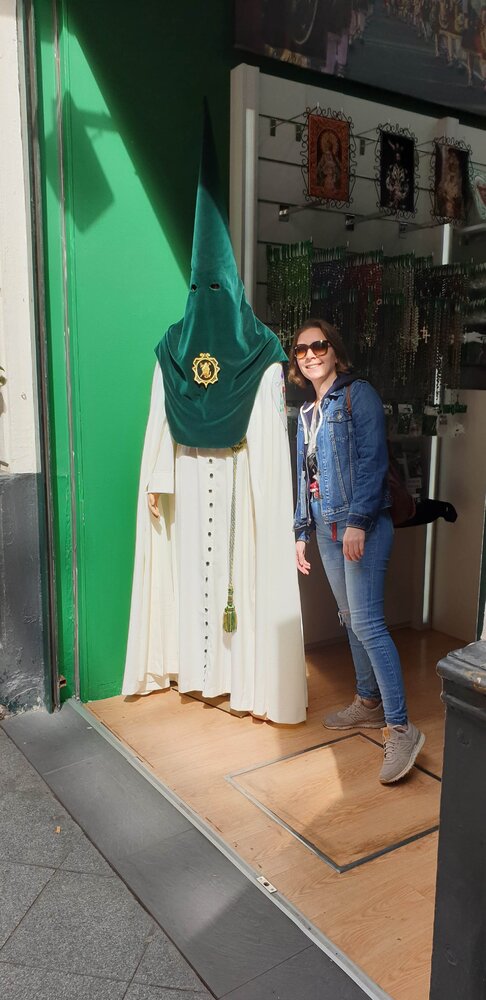 Why are such costumes in Seville on Easter – read the article on the link
Why are such costumes in Seville on Easter – read the article on the link
Seville Fair (Feria de Abril)
The next time, prices for hotels in Seville take off during the annual April Fair, which takes place two weeks after Easter. And if a passionate week is a mixture of mourning and joy, then a fair is an extravaganza of joy when Rebuhito flows uncontrollably, and you must definitely wear folk costumes.
The dates of the holiday are tied to Easter, so every year they are different. Usually the fair falls on April or May.
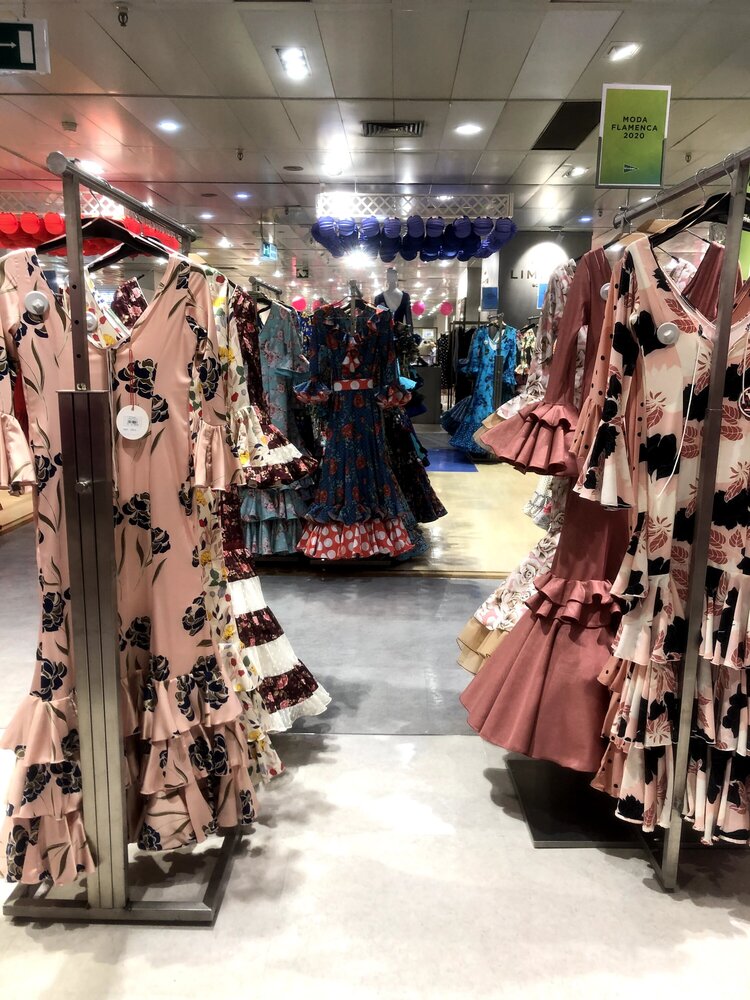 Festive clothing for the fair is sold in all shopping centers
Festive clothing for the fair is sold in all shopping centers
The holiday of the blood and body of Christ (Corpus Christi)
Another authentic local holiday is Christie’s corps, or the Eucharist's holiday – the appeals of bread and wine into the Body and Blood of Christ. It is celebrated only by the Catholic Church, and most clearly in Seville.
The traditions of Christie’s corps, like Semanes Santa, come from the XV or XVI century, when the Eucharist here began to celebrate large solemn processions – this holiday in the Catholic tradition is considered the third most important after Christmas and Easter. The whole city shines with festive lights, and the townspeople still decorate their balconies and windows, install mini-altars.
The main day of the holiday falls on Thursday, the 60th day after Easter. The morning begins with the festive mass in the cathedral (and this is a chance to get free to where only a paid entrance in the usual time), and then a solemn procession lasts about 4 hours along the streets of the city – with dancing, songs and magnificent carts. A detailed description of what is happening (in Spanish)
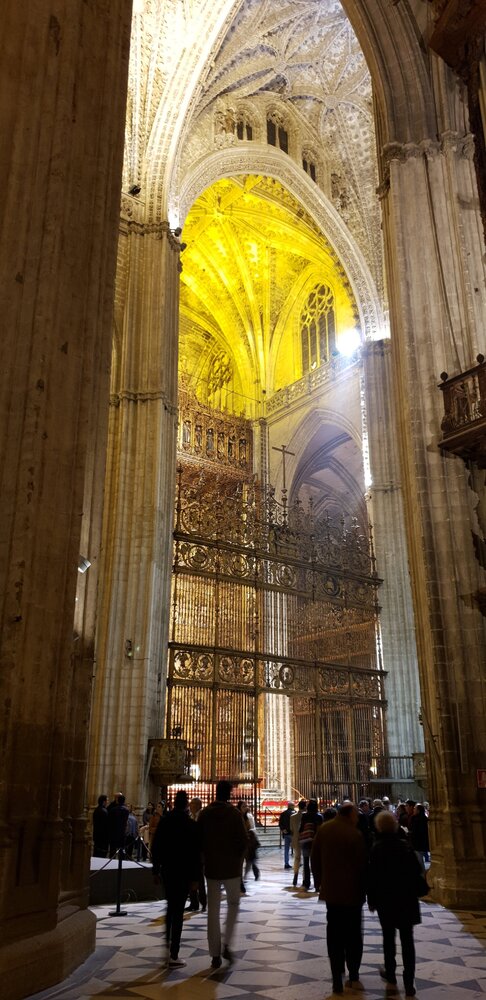 Seville Cathedral – the second in the world in size, after the Vatican
Seville Cathedral – the second in the world in size, after the Vatican
Weekend in Andalusia
A list of 14 days is public weekends when shops, museums and many restaurants are closed. However, even on a public weekend, some museums can work, so check the operating mode on their official sites.
- New Year: January 1.
- Epiphany (day of three kings): January 6.
- Day of Andalusia: February 28.
- Holy Thursday: April 9, 2020 (the date changes every year).
- Passion Friday: April 10, 2020 (the date changes every year).
- Seville Fair: Two weeks after Easter (dates change every year).
- International Day of Workers: May 1.
- Day of St. Ferdinand: May 30.
- Assumption of the Mother of God: August 15.
- Columbus Day: October 12.
- Day of all saints: November 1.
- Constitution Day of Spain: December 6th.
- Day of the immaculate conception: December 8.
- Christmas: December 25.
When is it best to go to Seville?
The best time to travel to Andalusia is spring and early summer. At this time, it is already very warm, but not too hot. From February to June, there are bright holidays that have no analogues. However, at this time the city has the most tourists.
The same weather, but without tourists and holidays, is autumn, starting in October. In December, they come to see one of the southern Christmas markets, which is part of the TOP-25 in Europe. And from July to September, only those who are not afraid of a “hot pan” is visited in the heat of the city.
TOP-5 excursions in Seville
- Seville Express – Acquaintance with the city (€ 94 per excursion)
To figure out the rich history of Spain and learn about the most beautiful places of the capital of Andalusia
On the heritage of ancient cultures, the fate of the monarchs and the traditions of simple Sevillanos on a sightseeing tour
Riddles of the quarter of Santa Cruz, plague epidemic, the grate of the devil and medieval traditions
To get acquainted with the bright world of Seville Gastronomy for a walk on classical institutions of the city
Walk the traces of opera characters, learn about the life of the Spanish aristocracy and see iconic places
For the first time in Seville?
Get it Free guide With a selection of our tips and recommendations:
We carefully selected the best restaurants, guides, hotels, sights and much more in Seville.

